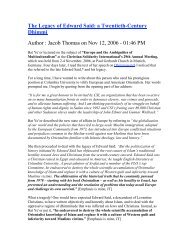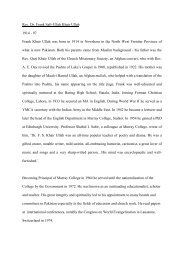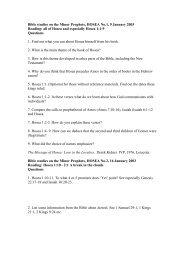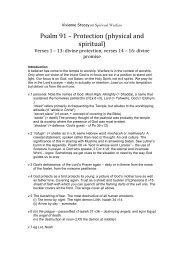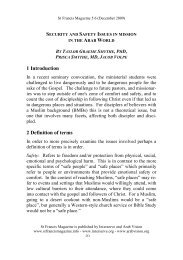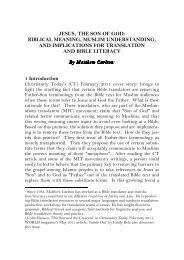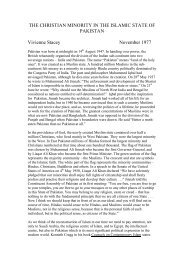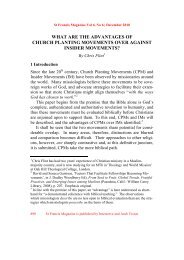download the pdf - St.Francis Magazine
download the pdf - St.Francis Magazine
download the pdf - St.Francis Magazine
You also want an ePaper? Increase the reach of your titles
YUMPU automatically turns print PDFs into web optimized ePapers that Google loves.
<strong>St</strong> <strong>Francis</strong> <strong>Magazine</strong> Vol 8, No 4 | August 2012<br />
C5 has been immediately rebuffed (Travis and Travis 2005: 413;<br />
Higgins in Corwin et al. 2007: 17). Elsewhere, without explaining<br />
his reasoning, Higgins (2007: 28) equates idolatry with syncretism,<br />
and differentiates insider movements from <strong>the</strong> situation in Acts 15,<br />
precisely because <strong>the</strong> latter instance calls for repentance from idolatry<br />
(2007: 37).<br />
Existing work examining idolatry from perspectives beyond<br />
missiology (e.g. Halbertal and Margalit 1992; Barton 2007) would<br />
inform a more helpful engagement with idolatry categories for both<br />
proponents and critics of insider movements. Higgins remains too<br />
vulnerable to charges of anthropological reductionism, even Gnosticism<br />
(Nikides 2009: 94-96, cf. Higgins 2009a: 81-83), and his assertion<br />
of <strong>the</strong> extension of <strong>the</strong> kingdom of God beyond <strong>the</strong> church is<br />
weak (Higgins 2009a: 85-88; cf. Nikides 2009: 102-111).<br />
Like idolatry, syncretism offers a multi-level analytical category<br />
(cf. Leopald and Jensen 2004) which is under-employed or used as<br />
an emotive term within <strong>the</strong> insider movement debate. Used well,<br />
<strong>the</strong>se terms will better inform issues such as whe<strong>the</strong>r Christians<br />
should use <strong>the</strong> Qur’an for clarification of an existing argument or<br />
for finding within it <strong>the</strong> gospel (Smith 2009: 29). Such employment<br />
of idolatry and syncretism will also open up new exegetical issues:<br />
would Paul and Barnabas in Acts 14 have instituted an insider<br />
movement within <strong>the</strong> Zeus cult in Lystra, and how does <strong>the</strong> answer<br />
to such a question inform our assessments of insider movements in<br />
our contemporary settings<br />
Whereas idolatry and syncretism might initially appear to be unexpected<br />
categories to introduce into an increasingly polarised and<br />
emotionally-charged debate such as that surrounding C5 and insider<br />
movements, <strong>the</strong>y do offer surprising potential for moving beyond<br />
dichotomous and polarising options. In particular, <strong>the</strong>y enable engagement<br />
with <strong>the</strong> dual notion of subversive fulfilment (cf. Schlorff<br />
2006: 17-19, 108-136), whereby Islam is both subverted and fulfilled<br />
– in its deepest longings – by <strong>the</strong> gospel. Under this schema, both<br />
similarities and differences can be held in <strong>the</strong> productive tension<br />
sought by Waterman (2007: 58), as can <strong>the</strong> uneasy distinction between<br />
<strong>the</strong> believer’s ‘primary’ and ‘secondary’ allegiances presented<br />
<strong>St</strong> <strong>Francis</strong> <strong>Magazine</strong> is a publication of Interserve and Arab Vision 491




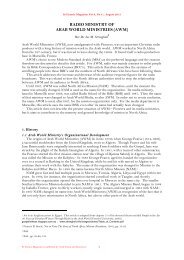
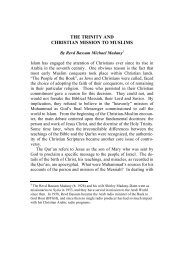
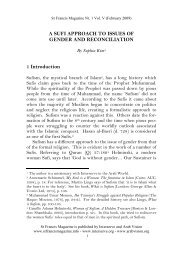
![Reflections on Surah Fatiha and the Lord's Prayer[1] - St.Francis ...](https://img.yumpu.com/49377951/1/184x260/reflections-on-surah-fatiha-and-the-lords-prayer1-stfrancis-.jpg?quality=85)
